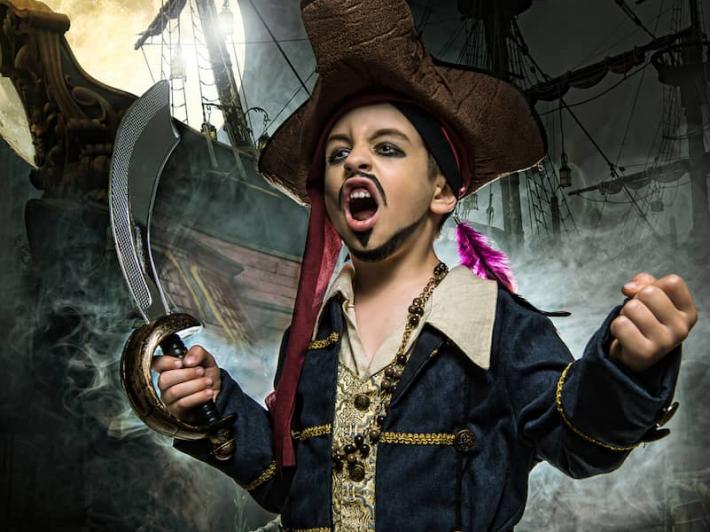Which Parts of ‘Pirate Talk’ Are Authentic and Which Come from Disney?
Based on the history of who was sailing the high seas, it’s a good bet pirates sounded a lot more multicultural than Ol’ Long John Silver would have us believe.
Valerie Fridland, Writing for

Listen
Which Parts of ‘Pirate Talk’ Are Authentic and Which Come from Disney?
Most of us only think of “Ahoy There, Matey!” and “Me Hearties!” once a year on International Talk Like A Pirate Day, a day when landlubbers can joke about walking the plank and being scalawags with abandon. But for linguists, the allure of pirate language and what it reveals about language and social life on the high seas is a year-round fascination.
Although the average person’s idea of how pirates spoke is generally limited to a random “arr” and “yar,” true pirate talk likely began in earnest in the late 1700s and early 1800s, a period known as the golden age of piracy.
Privateering and pirate ships were crewed by sailors from around the world.
Privateering and pirate ships were crewed by sailors from around the world, but the majority spoke a hybridized version of English known as Maritime Pidgin English. This variety was a contact English, or lingua franca, strongly influenced by European traders’ contact with West African languages and the multicultural diversity found on board slaving and trading ships.
In the 17th century, certain coastal ports became well known as “pirate nests,” offering safe harbor to those who felt marauding and pillaging made for a better living than more legal nautical gigs. According to historian Mark Hanna, author of “Pirate Nests and the Rise of the British Empire,” one well-known pirate nest was in what is referred to as the “West Country” in Southwestern England, an area that includes counties such as Devon, Bristol, Dorset, and Cornwall.
This area had a long maritime history and also happened to be where many British sailors hailed from, including a fair number who turned to piracy. For instance, West County native Sir Francis Drake—a decorated sailor with a side hustle as a pirate and illegal slave trader—is a perfect example of how little difference there could often be. The famous dastardly pirate Blackbeard was also rumored to have been born in Bristol. As a result, some romanticizing about pirate life and language developed within this region based on its pirate proclivities.
So, when West Country native Robert Newton was tapped by Disney to play Long John Silver in the screen adaptation of “Treasure Island” by Robert Louis Stevenson, he played up iconic features of the West Country accent in portraying the character. Features like “arr,” which in West Country lingo means “yes,” and the merger of the sounds “ay” (e.g., “tie”) and “oy” (e.g., “toy”) so that “toy him up” involves ropes rather than Lego bricks, made for a pirate accent to remember.
Newton’s interpretation, rather than any real knowledge of what pirates actually sounded like, appears to have most influenced our notions of pirate talk and is probably why we think of pirates sounding like we do. But if it makes you feel better, most of the terms we associate with pirates—things like “Shiver me timbers” and “Me Hearties”—are indeed 18th century nautical terms, though back in that time they were used by anyone who happened to make a life or a living on a coast, not just pirates.
Most of the terms we associate with pirates—things like “Shiver me timbers” and “Me Hearties”—are 18th century nautical terms.
Avast, me hearties (faux pirate for “head’s up, friends”), there were pirates from many different language backgrounds, and they most likely spoke differently from the popular conception we have today. In fact, other features we think of as “pirate” hint at this more diverse linguistic history. For instance, the invariant “be” form we recognize from pirate speak, with “be” replacing “is” as in “He be a scalawag,” is a feature we find in Irish English. It turns out a good many Irishmen also made up the ranks of sailors and buccaneers, perhaps bringing with them their somewhat unusual use of “be.”
We also hear this “be” in a number of Caribbean Englishes and in African-American varieties of English. This suggests that the invariant “be” might have been frequent in the Maritime English that served as a lingua franca for linguistically diverse immigrants and slaves, influencing Caribbean and early African-influenced American language varieties via the many slaves, traders, and pirates who came to Caribbean and American ports.
And the Caribbean Islands weren’t just ports of call; they were also spots where smart pirates tended to winter or retire. Two famous pirates, Sam Lord and Stede Bonnet, called Barbados home, and Blackbeard was also a frequent visitor. Perhaps not surprising given its popularity as a port for British and Irish immigrants and pirates, phonetician John Wells suggests the Barbadian accent is reminiscent of pirate talk in his book “Accents of English.”
As the saying goes, dead men tell no tales, nor do they help us much with figuring out what real pirates might have sounded like, especially since there weren’t a lot of pirate recordings made back in the day. But, based on the history of who was sailing the high seas, it’s a good bet they sounded a lot more multicultural than Ol’ Long John Silver would have us believe.
